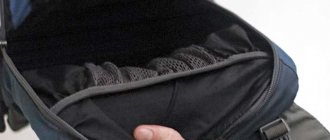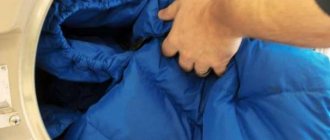Most backpacks are made from nylon. They can be safely washed in a washing machine, except for those backpacks that have a waterproof layer or impregnation. By feeling the material from which your hiking bag is made, you can determine the presence of such a layer. If one side (usually the inside) is smooth and the other is not, this means your backpack has a waterproof layer. Backpacks with a waterproof coating should be hand washed following the instructions below and should not be dried using heat.
Where to begin?
Start by completely emptying your backpack. Feel all the corners of the pockets and compartments - pull out everything you find in them. If there is a lot of dust and debris in your pockets, vacuum them. Look inside (in the main compartment or in the pockets) for a label with washing instructions for your backpack.
How to wash a backpack in the washing machine
- Unzip all zippers on the backpack, as they may be damaged if washed closed.
- Check that all buckles and straps are secure.
- If you have a top-loading washing machine, place the backpack in a laundry bag or pillowcase - this will keep the straps from getting tangled.
- If your backpacking bag has an internal frame, remove it. The frame may become bent or damaged in the washing machine and may tear the fabric.
- Inspect the backpack thoroughly, checking for any stains, tears or fraying of the fabric. If you find a frayed area, use the backpack's hand-washing instructions as washing the bag will cause further wear on the damaged area.
- Remove or pre-treat any dirty stains.
- Wash the backpack using cold water and the delicate program. If the backpack is very large, take it to the laundromat (they have large washing machines) or hand wash it in the bathtub.
- Hang your backpack over the bathtub to allow water to run off so it can dry.
Washing methods
There are only 2 types of washing: hand and machine. It is important to understand that the second option is more delicate and economical. Machine washing has a more aggressive effect on the material. But it is important to remember about the combined option, which can be called one of the most popular. With this type of washing, complex stains, greasy stains and abrasions are removed manually. If there is no ban on washing in automatic mode, you can thoroughly wash the bag in the machine. But first things first.
How to wash a backpack in the washing machine
Let's start with cleaning in automatic mode, because it is in this case that the risk of making a fatal mistake and completely ruining an expensive item increases significantly. Just a few warnings. Most professional backpacks made of cordura, membrane and polyethylene do not tolerate machine washing well. The first material is very hard and dense. Initially, it is not moisture resistant, but in combination with polyethylene on the inside, the model is able to withstand a fairly dense water column. The membrane is the most capricious material. Such products require very careful and careful washing. Most often, there is simply no need to resort to automatic processing, because... The membrane can be cleaned very well by hand in cold water. Polyethylene can simply come apart in the drum, so it is best to wash regular models of school backpacks in a washing machine.
Basic Rules:
- Complete all preparatory work. We have already described them in detail. These include: studying the material and analyzing the presence of rigid structures. Don't forget to remove your personal items and turn your backpack inside out.
- Soak the most difficult areas of dirt with a soap solution, washing powder or gel. It is impossible to get rid of grease stains, abrasions and other difficult stains in the drum of the machine, so such problems will have to be solved manually in advance.
- Set the temperature. Do not forget that the temperature Celsius should not exceed 30-40 degrees. If your washing machine has a delicate wash function, choose it. Don't forget to turn off the spin mode - it can damage the fabric and structure of the material.
- Do not rush to place a hard item of clothing into the drum of the washing machine. It is preferable to wash such items in a special bag. If you don’t have one, you can simply wrap the backpack turned inside out in a sheet and tie it.
- All that remains is to select the appropriate washing mode, select a cleaning agent and start the wash. The chemical cleaner should be selected based on the recommendation in Chapter: Selecting a Cleaner. If you missed it, try to use the mildest gel-based chemicals. They are more versatile. The washing mode can be delicate (or an equivalent, depending on the model of the washing machine).
If after the first attempt you cannot get rid of all the dirt, then repeat the procedure or wash it by hand. Be sure to carefully read the label on your backpack. If the machine wash icon is crossed out, then you should not tempt fate. A backpack is a thing that can be easily washed by hand. If you are wondering, is it possible to wash a backpack in a washing machine? The answer is clear: you can. We have already listed the factors that should be taken into account.
How to wash a backpack by hand
And yet, most people are well aware that school backpacks can be washed in a washing machine. This is understandable on a purely intuitive level, and the degree of contamination is usually not so significant in comparison with professional camping analogues. The risk is much lower, because the price of professional equipment exceeds several hundred dollars, and the functional purpose is really very wide. Models made of membrane, cordura, backpacks with a rigid frame to distribute the load, analogues with a large number of fastening elements, bags with a large number of rigid inserts, with large and thick zippers or carabiners will have to be washed only by hand.
But this should not be taken as a disadvantage. For example, you can skip the not-so-simple preparatory step of removing the frame and other detachable elements. And yet, hand washing does not exclude a number of restrictions. Since it will be difficult to provide all the materials and types of fabric, we will take as a basis a membrane travel backpack with a rigid frame and several removable pockets. This option has the most restrictions on washing. And we will consider other types of materials below. Here are some important rules:
- We check our pockets and take out all personal belongings.
- Remove the detachable outer pockets. This is not necessary, but will allow you to better clean the item of clothing.
- Wipe with a damp cloth. This will help you better examine dirty and greasy stains, understand which of them will be washed off after contact with a light brush, and which will have to be soaked. It is especially worthwhile to go over the edge seams.
- A common problem with backpacks before washing is the presence of a strong odor inside. In this case, you can pour a fairly large amount of soda or potato starch inside. If you fasten the zippers and shake the backpack thoroughly, these materials will act as absorbents, literally absorbing all odors.
- It is better to get the sealing inserts if possible. The fact is that they can also absorb bad odors. But it will be difficult to wash them from the outside, so you will have to deal with them separately.
- Wet the backpack with a shower or tap in a bowl. It is important to choose the right temperature: it should not be hot. If you open hot water taps to maximum, the structure of the fabric may be damaged. In the case of a membrane, it is better to try to wash it in slightly cool water so as not to damage the delicate material.
- We inspect the soaked backpack again: if there are very greasy stains and heavy dirt, we use a stain remover. Just first you need to study the label to make sure that the chemicals can be used. Otherwise, the membrane may absorb chemical compounds. They will clog the pores of the membrane, and the fabric will turn into ordinary polyethylene.
- Lather the brush with cleaning agent. Sometimes regular laundry soap is enough. Choose the most delicate product possible.
- Using a soft brush, lather the surface as thoroughly as possible, constantly adding a small amount of warm water to make the effect effective. After lathering the entire surface, leave the backpack for 15-20 minutes to react, then lather the cleaner again.
Finally, all that remains is to wash off the dirty foam with water. Do this as carefully as possible so that no harmful compounds remain inside the fabric. Also, do not use fabric softeners or machine wash powders. They can effectively remove dirt stains, but they cannot be washed off by hand, which is why smudges and white stains remain. For subsequent drying, it is strictly forbidden to use a hair dryer. You should not place your backpack on a warm radiator. When drying your backpack, it is recommended to use natural methods. In this case, the bag may take several days to dry, but there is no other safe method.
How to wash a backpack by hand
- Fill a bucket or tub with enough water to completely cover your backpack.
- Add laundry detergent to the water and stir vigorously by hand.
- If your backpack has an internal frame, it's best to pull it out. Although hand washing is a fairly gentle process and the frame tubes will not tear the fabric, the metal can begin to rust from excessive exposure to water.
- Place the backpack in the water and gently swirl it around to wet all sides.
- If there are any particularly dirty areas, scrub them with an old toothbrush or clothes brush.
- Rinse your backpack thoroughly in the shower.
- Hang your backpack over the bathtub to allow water to run off so it can dry.
Wet cleaning
You can remove dirt and give the product a decent appearance without washing. Procedure:
- Shake the backpack and pat the side walls with your hand to shake out any small debris that accumulates in the seams.
- Open all pockets and, if possible, turn the main compartment outward as much as possible.
- Turn the backpack over a trash can or sink and shake it so that all the garbage spills out.
- Using a special small nozzle, vacuum the backpack.
- Wipe the internal sections with damp wipes, paying special attention to the seams. For a school backpack, it is better to take antibacterial ones.
- The method for cleaning the external surface depends on the material. You can use a dry brush for natural fabrics, for leather or moisture-resistant textiles - wet wipes, foam cleaner, spray.
- After cleaning, it is advisable to leave the backpack open for airing for a few minutes.
- If the material allows (genuine leather, suede), the surface must be treated with a special water-repellent spray or cream.
How to wash a backpack in the dishwasher
Although the dishwasher can be used to wash shoes, baseball caps, and other household items, it is not recommended to wash your backpack in the dishwasher. The temperature in a dishwasher is much higher than in a washing machine - it can damage the material or cause paint to fade. Additionally, dishwashers have rotating spray arms in the work compartment, which can get caught on the straps, damaging both the backpack and the dishwasher. If you still want to machine wash your backpack, place it in a pillowcase or loose laundry bag. If your camp bag can fit on the top shelf, put it there. Use a non-bleach detergent and remove the backpack before the drying cycle begins. Hang your backpack over the bathtub to allow water to run off so it can dry.
Contraindications for care
In order for the fabric to retain its visual appeal and strength for a long time, it is prohibited:
boil or wash things at temperatures above 40. High temperatures destroy the structure of the fibers and deform the fabric;- treat products with harsh detergents containing chlorine, various bleaches or stain removers;
- twist by hand or use high spin speeds when machine washing;
- dry in the sun, hot radiators or other heat sources.
How to wash a polyester backpack
Polyester is a very versatile fabric that is generally strong and durable, regardless of whether it is thick or not. If your backpack does not have any special embellishments such as studs, studs or leather trim, it can be safely machine washed using cold water on the delicate cycle. However, polyester is also known for absorbing and storing body odors, so give your backpacking bag a sniff and, if necessary, treat the back and straps using the "how to wash backpack straps" method below.
How to wash backpack straps
The straps and straps of a backpack collect the most sweat and dirt because they are in constant contact with your hands. They can be washed separately periodically, which will reduce the overall wear and tear on the backpack fabric and increase its service life.
- Mix a small amount of dishwashing liquid or shampoo with water, then stir the water vigorously to create a lather.
- Using a toothbrush or clothing brush, apply the resulting foam to the belts and scrub thoroughly.
- Rinse the belts under the tap, or wipe them with a little water. If your belts have filling inside, try not to get them completely wet, otherwise they will take much longer to dry.
- To help the straps dry quickly, hang the backpack outdoors.
How to wash a backpack with leather parts
Unless otherwise stated on the care label, a backpack with leather trim or leather parts should not be completely washed to avoid getting the leather wet. Areas of fabric with dirty stains are treated separately.
- Mix a small amount of dishwashing liquid or laundry detergent with water, then stir the water vigorously to create a suds.
- Using a toothbrush or clothing brush, apply the resulting foam to dirty stains.
- Rub the brush thoroughly into the treated areas of the backpack.
- Rinse the cleaned area with a sponge and clean water.
- Dry the fabric of the backpack and then let it dry in the fresh air.
- Wash your leather parts by following the instructions in our How to Clean Genuine Leather guide.
Proper drying
Drying is carried out in a vertical position. Turn the washed backpack inside out and secure it to coat hangers and place it in an area with good air flow. When the lining is dry, turn the product right side out and leave to dry.
Some types of textile backpacks can be ironed, a label inside will tell you this. Be sure to follow the recommended temperature conditions and iron through a cotton cloth to avoid leaving shiny marks on the surface.
Backpacks made of leatherette, genuine leather, and impregnated materials are prohibited from being dried on the fireplace.
How to wash a backpack with rivets
The external finishing of the backpack with metal studs and rivets gives it a unique look, but at the same time adds special care requirements. It is best to avoid getting water on metal parts as they may rust. Therefore, such backpacks cannot be washed completely; only dirty spots on them are cleaned.
- Mix a small amount of dishwashing liquid or laundry detergent with water, then stir the water vigorously to create a suds.
- Using a toothbrush or clothing brush, apply the resulting foam to dirty stains.
- Give the dirty areas of the backpack a good scrub with the brush.
- Rinse the cleaned area with a sponge and clean water.
- Dry the backpack fabric.
- Gently polish the studs and rivets with a soft, dry cloth.
Features of the material
Polyester is one of the most popular synthetic materials. The fabric is created by weaving the main and transverse threads. Externally, polyester resembles wool, but its characteristics are very similar to cotton.
Polyester synthetic fabric is different:
long service life - not subject to abrasion, mechanical stress, stretching;- resistance to the absorption of dirt and odors - the special structure of the surface of the fibers does not allow dirt to penetrate and accumulate inside the fabric;
- low creasing - fabric fibers are practically not deformed during washing and drying. Quickly release moisture, forming a smooth surface;
- color fastness - does not fade, tolerates repeated washing, does not fade when exposed to sunlight;
- moisture, wind and cold resistance - the material does not get wet and retains heat well;
- ease of care - if washing recommendations are followed correctly, items made of polyester retain their beautiful appearance for a long time;
- immunity to the effects of aggressive chemicals, the development of bacteria and microorganisms.











